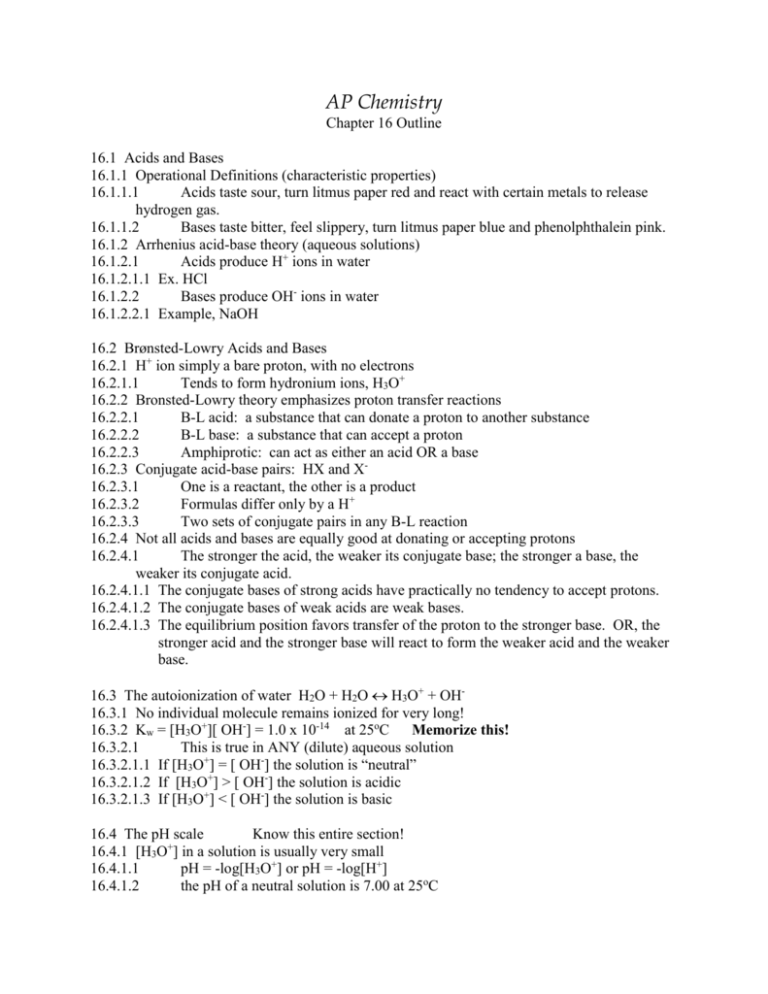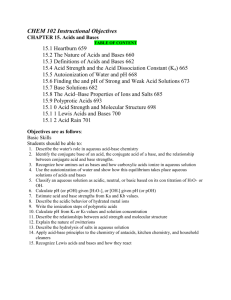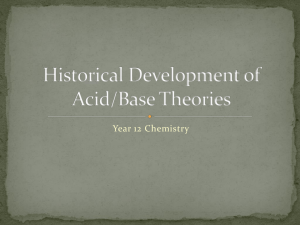AP Chemistry
advertisement

AP Chemistry Chapter 16 Outline 16.1 Acids and Bases 16.1.1 Operational Definitions (characteristic properties) 16.1.1.1 Acids taste sour, turn litmus paper red and react with certain metals to release hydrogen gas. 16.1.1.2 Bases taste bitter, feel slippery, turn litmus paper blue and phenolphthalein pink. 16.1.2 Arrhenius acid-base theory (aqueous solutions) 16.1.2.1 Acids produce H+ ions in water 16.1.2.1.1 Ex. HCl 16.1.2.2 Bases produce OH- ions in water 16.1.2.2.1 Example, NaOH 16.2 Brønsted-Lowry Acids and Bases 16.2.1 H+ ion simply a bare proton, with no electrons 16.2.1.1 Tends to form hydronium ions, H3O+ 16.2.2 Bronsted-Lowry theory emphasizes proton transfer reactions 16.2.2.1 B-L acid: a substance that can donate a proton to another substance 16.2.2.2 B-L base: a substance that can accept a proton 16.2.2.3 Amphiprotic: can act as either an acid OR a base 16.2.3 Conjugate acid-base pairs: HX and X16.2.3.1 One is a reactant, the other is a product 16.2.3.2 Formulas differ only by a H+ 16.2.3.3 Two sets of conjugate pairs in any B-L reaction 16.2.4 Not all acids and bases are equally good at donating or accepting protons 16.2.4.1 The stronger the acid, the weaker its conjugate base; the stronger a base, the weaker its conjugate acid. 16.2.4.1.1 The conjugate bases of strong acids have practically no tendency to accept protons. 16.2.4.1.2 The conjugate bases of weak acids are weak bases. 16.2.4.1.3 The equilibrium position favors transfer of the proton to the stronger base. OR, the stronger acid and the stronger base will react to form the weaker acid and the weaker base. 16.3 The autoionization of water H2O + H2O H3O+ + OH16.3.1 No individual molecule remains ionized for very long! 16.3.2 Kw = [H3O+][ OH-] = 1.0 x 10-14 at 25oC Memorize this! 16.3.2.1 This is true in ANY (dilute) aqueous solution 16.3.2.1.1 If [H3O+] = [ OH-] the solution is “neutral” 16.3.2.1.2 If [H3O+] > [ OH-] the solution is acidic 16.3.2.1.3 If [H3O+] < [ OH-] the solution is basic 16.4 The pH scale Know this entire section! 16.4.1 [H3O+] in a solution is usually very small 16.4.1.1 pH = -log[H3O+] or pH = -log[H+] 16.4.1.2 the pH of a neutral solution is 7.00 at 25oC 16.4.1.3 the pH of an acidic solution is <7 16.4.1.4 the pH of a basic solution is >7 16.4.1.5 for mental math: if [H3O+] is 1 x 10-x, pH = x (you can use this to estimate pH) 16.5.2 pOH = -log[OH-] Be able to do calculations with these equations! 16.5.3 pH + pOH = 14 16.5.4 Measuring pH 16.5.4.1 Use a pH meter 16.5.4.2 Use indicators (less precise) 16.5 Strong acids and bases 16.5.1 Strong electrolytes that exist in aqueous solutions entirely as ions 16.5.1.1 Memorize the strong acids: HCl, HBr, HI, HNO3, HClO3, HClO4, H2SO4 16.5.1.2 In aqueous solutions of strong acids, the acid is the only significant source of H+ ions 16.5.1.2.1 Typically ignore the H+ concentration from the autoionization of water 16.5.1.2.2 [H+] = the original concentration of the acid for monoprotic acids 16.5.1.3 Memorize the strong bases: hydroxides of the alkali metals and the heavier alkaline earth metals 16.5.1.3.1 Basic anhydrides: metal oxides will form hydroxides when dissolved in water 16.6 Weak acids 16.6.1 Most acidic substances are weak acids, only partially ionized in solution 16.6.1.1 HA(aq) H+(aq) + A-(aq) or HA(aq) + H2O(l) H3O+(aq) + A-(aq) [ H O ][ A ] [ H ][ A ] 16.6.1.1.1 or K a 3 Ka [ HA] [ HA] 16.6.1.1.2 note that only H atoms attached to oxygen atoms show acidic behavior 16.6.1.1.3 the larger the value of Ka, the stronger the acid 16.6.2 Calculating Ka from pH 16.6.2.1 Write out balanced equation & Ka expression 16.6.2.2 Set up an ICE table to find concentrations of the species involved 16.6.2.2.1 Assume that (initial acid concentration – change) (initial acid concentration); 16.6.2.2.2 OK if % ionization is < 5% or if Ka is 10-4 (this will avoid needing to use the quadratic formula) 16.6.2.3 Substitute into Ka expression and evaluate 16.6.2.4 The pH of a weak acid solution is higher than that of a strong acid of the same molarity change in [ HA] % ionization 100 16.6.2.5 initial [ HA] 16.6.3 Polyprotic acids have more than one ionizable hydrogen atom. 16.6.3.1 H2A H+ + HAKa1 + 216.6.3.1.1 HA H + A Ka2 16.6.3.2 It is always easier to remove the first proton than following protons. 16.6.3.2.1 Ka1 > Ka2 16.6.3.2.2 As long as successive Ka values differ by a factor of 103 or more, consider only Ka1 16.7 Weak bases 16.7.1 Weak bases may either … 16.7.1.1 Have a pair of nonbonding electrons that can accept a proton OR 16.7.1.2 be the anions of weak acids 16.7.2 B(aq) + H2O HB+(aq) + OH-(aq) [ HB ][OH ] 16.7.2.1 be able to do ICE-style problems with this Kb [ B] 16.8 Relationship between Ka and Kb 16.8.1 Ka x Kb = Kw for a conjugate acid-base pair! MEMORIZE THIS 16.8.1.1 If you know Ka for a weak acid, you can use this relationship to solve for Kb of its conjugate base 16.8.2 Often, Ka values are reported as pKa (-log Ka) 16.8.2.1 pKa + pKb = pKw = 14.00 at 25oC 16.9 Acid-base properties of salt solutions 16.9.1 Ions can exhibit acidic or basic behavior 16.9.2 Hydrolysis reaction: salt + water acid + base 16.9.3 Predicting the pH of salt solutions: 16.9.3.1 An anion that is the conjugate base of a strong acid will not affect the pH. 16.9.3.2 An anion that is the conjugate base of a weak acid will produce a basic solution. 16.9.3.3 A cation that is the conjugate acid of a weak base will produce an acidic solution. 16.9.3.4 The cations of the strong Arrhenius bases will not affect the pH. 16.9.3.5 Other metal ions will produce an acidic solution. 16.9.3.6 If both the conjugate base of a weak acid and the conjugate acid of a weak base are present, the ion with the larger Ka or Kb value will determine the pH of the solution. 16.10Acid-Base behavior and chemical structure 16.10.1Three main factors: 16.10.1.1 A molecule containing hydrogen will transfer a proton only if the H-X bond is polarized so that the H atom has a + charge and the X atom has a - charge 16.10.1.2 Very strong bonds are less easily dissociated than weaker ones. 16.10.1.3 The greater the stability of the conjugate base, the stronger the acid. 16.10.2Binary Acids 16.10.2.1 Acidity decreases down a column 16.10.2.1.1 H-X bond strength decreases as X increases in atomic radius 16.10.2.2 Acidity increases L-R in a period 16.10.2.3 H-X bonds become more polar going L-R 16.10.3Oxyacids 16.10.3.1 As central atom becomes more electronegative, acid strength increases 16.10.3.2 For the same central atom, acid strength increases as the number of oxygen atoms increases KNOW THIS 16.10.3.2.1 Because electron density is pulled away from the OH bond, making it more polar 16.10.4Carboxylic acids 16.10.4.1 Resonance structures for the conjugate base help to stabilize it 16.11 Lewis acids and bases—broadest theory of the 3 Know this whole section! 16.11.1 Lewis acid = electron pair acceptor 16.11.1.1 Lewis acids have an empty valence orbital 16.11.1.2 Many cations can act as Lewis acids 16.11.2 Lewis base = electron pair donor 16.11.2.1 Lewis bases have a lone pair of electrons 16.11.3 Hydrolysis of metal ions 16.11.3.1 hydration as a Lewis acid-base reaction 16.11.3.1.1 as charge increases, metal ion is more acidic 16.11.3.1.2 as radius decreases, metal ion is more acidic 16.11.3.1.3 Note: Lewis acid-base theory also relevant for complex ion reactions







